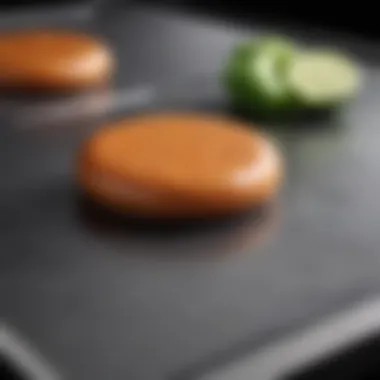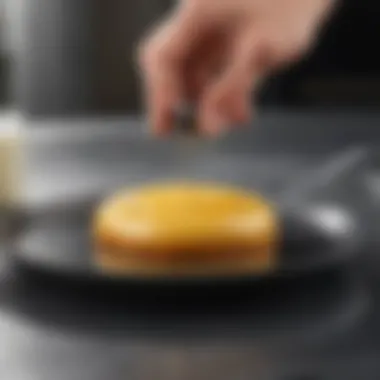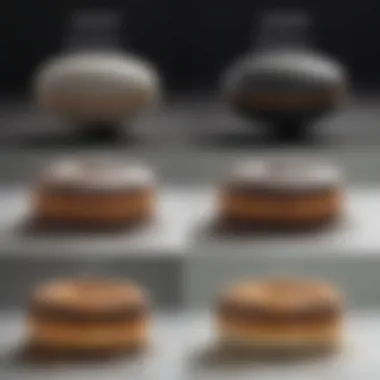Understanding All-Clad Non-Stick Coating Composition


Intro
When it comes to cookware, most people have heard the name All-Clad. Known for their superior quality and craftsmanship, All-Clad products are cherished not just by home cooks but by professional chefs as well. One key aspect that sets All-Clad apart is their non-stick coating. Understanding the intricate composition of this coating can offer valuable insights into why All-Clad remains a preferred choice in kitchens around the world.
The journey to mastering cooking often begins with choosing the right tools. Non-stick coatings have evolved significantly over the years, improving both performance and safety. All-Clad has made a name for itself in this arena, creating non-stick cookware that not only enhances cooking but also simplifies cleanup. This exploration delves into the materials that make up All-Clad’s non-stick coating, the manufacturing processes involved, and the properties that contribute to its durability and safety.
In a world increasingly concerned with food safety and environmental impact, knowing what goes into our cookware can be crucial. It’s about more than just cooking—it's about understanding the interplay of science and art in culinary creations. Let’s dive deeper into the world of All-Clad’s non-stick coatings.
Understanding Non-Stick Coatings
The realm of non-stick coatings is far more intricate than the average cook might think. It is not solely about the convenience of flipping pancakes or effortlessly removing an omelet from the pan. Grasping the essential nature and significance of non-stick coatings can equip both culinary novices and seasoned chefs with knowledge that goes beyond mere cooking. Understanding these coatings entails recognizing the benefits they offer in terms of food release, ease of cleaning, and overall cooking proficiency. Moreover, awareness of the factors influencing a non-stick coating's performance can lead to wiser cookware choices that enhance the cooking experience.
Definition and Purpose
At its core, a non-stick coating is a surface treatment that diminishes the adhesion of food, allowing for easy release when cooking. This characteristic is vital for various cooking techniques, like sautéing or frying. The most recognized non-stick coating material is Polytetrafluoroethylene, commonly referred to as PTFE. This unique compound makes it possible for food to slide right off the surface, minimizing the need for excess oil or butter, which can be a boon for those looking to cut down on fat in their diets. Furthermore, the non-stick surface vastly improves the ease of cleanup, an aspect not to be overlooked for busy kitchens.
Historical Development
The historical journey of non-stick coatings is quite fascinating, marked by innovation and adaptation. PTFE was discovered accidentally in the 1930s by scientist Roy Plunkett. Initially used in industrial applications, this material found its place in the culinary world in the 1950s when cookware manufacturers realized its potential for home chefs. Over time, this development led to various iterations of non-stick surfaces, including newer alternatives like ceramic and composite materials aimed at improving safety and performance. As consumer awareness of health implications grew, manufacturers have had to adapt, implementing additional safety measures and even exploring greener options.
"Innovation in the kitchen starts with understanding the tools and materials we use. Non-stick coatings are not just a convenience; they're a blend of science and art that can elevate our culinary practices."
The evolution of non-stick cookware reflects broader trends in culinary technology, revealing a growing intersection between cooking, science, and environmental responsibility. By examining the background and aims of these coatings, one can better appreciate their role in modern cooking, ensuring meals are not only delectable but also prepared with ease.
Composition of All-Clad Non-Stick Coating
Understanding the composition of All-Clad non-stick coating is key to appreciating its performance and longevity. This section will dive into the materials used in its production, production techniques, and the overarching benefits these elements bring to both culinary enthusiasts and professionals. Non-stick coatings play a vital role in the ease of cooking and cleaning, health safety, and overall satisfaction for the consumer. Knowing what goes into these coatings helps users make informed decisions about their culinary tools.
Types of Materials Used
Polytetrafluoroethylene (PTFE)
Polytetrafluoroethylene, commonly known as PTFE, is perhaps the most recognized material in non-stick cookware. Its slippery surface is renowned for offering impressive non-stick properties, allowing food to slide off with minimal effort. This key characteristic of PTFE comes from its molecular structure, providing resilience against high temperatures while resisting chemical reactions with food.
One unique feature of PTFE is its low friction coefficient, making it a popular choice for chefs who value efficiency and ease in cooking. However, there are disadvantages—if overheated beyond 500°F, PTFE can release toxic fumes. Hence, while it offers substantial benefits in meal preparation, users must be careful to avoid extreme conditions.
Reinforced Ceramic
Reinforced ceramic emerges as a strong alternative to traditional non-stick coatings. Its key characteristic is not only its scratch resistance but also its capability to withstand higher temperatures compared to some synthetic coatings. This makes it particularly appealing for those who prefer using metal utensils without worrying about damaging the surface.
A unique aspect of reinforced ceramic is its natural composition, often free of PTFE and other harmful chemicals, appealing to health-conscious consumers. Still, it does struggle with certain common challenges; for instance, it may not be as non-stick as PTFE under certain cooking conditions, requiring a bit more oil or fat to be added to prevent sticking.
Composite Materials
Composite materials showcase an advanced fusion of substances that aim to leverage the strengths of each. By combining PTFE with other protective elements, manufacturers can create a coating that enhances durability while retaining excellent non-stick properties. The beauty of composites lies in their comprehensive design aimed at mitigating the weaknesses found in singular materials. One key characteristic is their ability to resist wear and tear effectively, lending to greater longevity of the cookware. The disadvantage remains that composite surfaces can sometimes be pricier than their straightforward counterparts. Nonetheless, the investment is often justified due to enhanced cooking performance and cleaner preparation experiences.
Production Techniques
Layering Process
The layering process is essential in crafting All-Clad's non-stick coatings, as it involves applying multiple coats to develop a strong and resilient surface. This technique ensures that each layer is uniformly distributed, providing a robust barrier against food sticking. The principal advantage of this method is that it allows for customization in terms of thickness, leading to variability in non-stick performance based on individual consumer needs. However, if not executed correctly, the outcome can be uneven, leading to compromised performance over time.


Temperature Control
Temperature control during the manufacturing phase is pivotal. It ensures that each layer adheres properly and reaches its optimal performance level after application. Maintaining appropriate temperatures prevents the coating from bubbling or degrading, which would compromise its integrity. This careful manipulation of heat is beneficial because it not only preserves the non-stick surface but also reinforces its durability against scratches and wear.
Surface Treatment
To maximize their effectiveness, All-Clad non-stick coatings undergo various surface treatments. Treatments may include adding additional non-stick enhancers or sealing the surface to resist damage over the long haul. The enormous advantage of surface treatment lies in its capability to enhance the resilience of the coating against wear and food particle build-up. As a downside, misuse of cleaning materials or procedures can counteract these treatments, so educating consumers on care is paramount.
Safety and Environmental Aspects
Understanding the safety and environmental implications of All-Clad non-stick coatings is crucial for consumers, especially those who are health-conscious or environmentally aware. This section dives into significant elements like health considerations and environmental practices, which impact a user’s experience and the planet alike.
Health Considerations
Chemical Leaching
Chemical leaching is a notable concern among cookware users, particularly regarding non-stick surfaces. It's about how certain compounds can migrate from the cookware into food when heated. The key characteristic of chemical leaching in the context of All-Clad’s products is their rigorous testing and adherence to safety standards. This attention to detail ensures that harmful substances do not seep into your food while cooking.
Unique Feature: The non-stick surface is designed to withstand high temperatures without breaking down, which minimizes the risk of leaching. Studies have shown that when using reputable brands, including All-Clad, there is a significantly reduced likelihood of chemicals transferring to food – making it a reliable option for everyday cooking.
On the downside, not all non-stick cookware is created equal. Some lower-quality options might be prone to leaching at lower temperatures, raising concerns about their safety. Hence, choosing brands that prioritize safety, like All-Clad, becomes essential for preventative health measures.
Non-Toxic Standards
On a similar note, the concept of non-toxic standards isn’t just a marketing term. It serves as a benchmark for assessing cookware safety. All-Clad’s non-stick coatings comply with stringent non-toxic standards—meaning potential harmful substances like PFOA, which have raised alarms in the cooking community, are excluded from their manufacturing process.
Key Characteristic: These non-toxic formulations revolve around using materials that are both effective in providing non-stick properties and safe for culinary use.
Unique Feature: While some coatings may wear out and expose underlying materials, All-Clad's design ensures that even with regular wear, the safety of the coating remains intact. This structure allows users to cook without worrying about toxicity in their meals.
Environmental Impact
Source of Raw Materials
When considering the environmental aspect, understanding the source of raw materials is vital. All-Clad emphasizes the use of responsibly sourced materials for their non-stick coatings, ensuring minimal environmental disruption during extraction and processing. This means that they aren't only focused on performance; they also regard the impact their materials have on the planet.
Key Characteristic: The choice of raw materials reflects a balance between performance and responsibility. Being from suppliers who align with sustainable practices, All-Clad addresses both the quality and environmental aspects, establishing a rapport of trust among eco-conscious customers.
Unique Feature: Using high-quality, sustainably sourced materials may also contribute to improved durability. Better materials mean a longer-lasting product, which inadvertently helps reduce waste—an attractive trait for anyone keen on sustainable living.
Sustainability Practices
Another layer to the environmental impact is the sustainability practices involved in All-Clad’s production. The brand is not just about producing high-quality kitchenware; it encompasses a wider commitment to being environmentally friendly.
Key Characteristic: By employing energy-efficient manufacturing processes and maintaining a rigorous recycling program within their facilities, they demonstrate a commitment to reducing their carbon footprint.
Unique Feature: Such initiatives not only limit the waste created during production but also encourage customers to recycle old cookware. This provides a shared responsibility between the brand and consumer, promoting a cycle of sustainability and consciousness in culinary practices.
All-Clad aims to bolster consumer confidence not only through the safety of their products but also their commitment to environmentally wise choices.


Durability and Performance
The significance of durability and performance in All-Clad non-stick coatings cannot be overstated. This section dives into two critical aspects: non-stick longevity and cooking performance. Understanding these elements not only enhances the cooking experience but also ensures that the investment in quality cookware pays off in the long run.
Non-Stick Longevity
Durability Metrics
Durability metrics give insight into how long the non-stick surface can resist wear and tear. One fundamental characteristic that stands out is the coating’s scratch resistance. All-Clad implements a rigorous manufacturing process that aims for high durability, effectively locking in the non-stick properties longer than many competitors.
A notable feature of these metrics is the ability to withstand extreme temperatures, often reaching up to 500 degrees Fahrenheit without degrading. This is a significant advantage in various cooking scenarios, allowing chefs to sear meats and sauté vegetables at high heat without fear of ruining the surface. Moreover, consumer reports highlight that All-Clad pans stay effective for many years, which is a massive plus for those who use cookware frequently.
User Care Recommendations
To maintain the non-stick surface and prolong its lifespan, users should adhere to specific care recommendations. This involves using utensils like silicone, wood, or plastic, which do not scratch or damage the coating. Another essential aspect is proper cleaning; hand-washing with gentle soap and a soft sponge is recommended over machine washing.
The unique feature worth mentioning is the ease of maintenance; with suitable care, an All-Clad non-stick pan can remain pristine for an extended time. However, neglecting these recommendations can lead to reduced performance, which is a disadvantage for busy cooks who may overlook such care tips.
Cooking Performance
Heat Distribution
When discussing heat distribution, the evenness with which a pan heats up is crucial. All-Clad non-stick products are known for their superior heat conductivity, often made with a core of aluminum that helps in distributing heat uniformly. This characteristic minimizes hot spots, allowing food to cook evenly, which is essential for achieving culinary perfection.
Furthermore, the quick response to temperature changes adds convenience—ideal for tasks ranging from delicate sauces to hearty stir-fries. However, while consistent heat distribution is a beneficial aspect, it’s key that users understand that varying stove types can still affect outcomes, and adjustments might be necessary.
Ease of Cleanup
Finally, the ease of cleanup is a hallmark of non-stick cookware and one of the primary reasons many opt for All-Clad. The special coating allows food to slide off effortlessly, making post-cooking maintenance simple. Users often appreciate how quickly they can finish cooking and start enjoying their meals.
One unique feature of All-Clad's non-stick coatings is the ability to wipe out residue with minimal effort. However, it is vital to acknowledge that using the wrong cleaning tools can diminish this characteristic. Relying too heavily on abrasive scrubbers could shorten the lifespan of the coating, presenting a challenge for those who may prioritize quick cleaning shortcuts over proper care.
"With All-Clad, the performance in both cooking and cleaning reflects its commitment to quality and user satisfaction."
In essence, the durability and performance aspects of All-Clad's non-stick coatings are intricately linked together to create a cookware solution that many chefs and home cooks can rely on.
Comparative Analysis
In the culinary world, understanding how different cookware performs can make or break a cooking experience. This comparative analysis of All-Clad non-stick coatings against other brands provides valuable insights into their relative strengths and weaknesses. The importance of this comparison lies not just in identifying which pan gets the job done, but in the broader context of safety, durability, and culinary performance.
All-Clad versus Other Non-Stick Brands
Performance Comparison
The performance comparison of All-Clad non-stick cookware versus other brands centers on heat retention and release properties. While many competitors tout impressive non-stick capabilities, All-Clad stands out due to its robust construction. Its multi-layered structure ensures even heat distribution, which is crucial for cooking delicate items like eggs or pancakes without sticking.
One unique feature that sets All-Clad apart is its ability to withstand high temperatures without degrading or emitting harmful substances. On the flip side, some non-stick alternatives might suffer from performance drop-offs when pushed to extreme heat. This phenomenon not only affects cooking performance but raises safety concerns for users.


The advantages of All-Clad's performance include:
- Superior heat distribution, resulting in evenly cooked food.
- High durability that prolongs the life of the cookware.
- A more consistent experience across different cooking methods.
However, it’s worth noting that these benefits come with a higher price tag, which may deter budget-conscious consumers.
Ingredient Transparency
Ingredient transparency is increasingly becoming a pivotal issue for consumers, and it plays a significant role in the comparative analysis of non-stick brands. All-Clad is known for its commitment to disclosing the materials used in its coatings. This transparency fosters trust among consumers who are becoming more discerning about what they’re using in their kitchens.
A notable aspect of All-Clad’s ingredient transparency is its assurance of non-toxic materials that meet regulatory standards. This not only alleviates health concerns but also appeals to consumers prioritizing their well-being.
In contrast, some other brands may maintain a cloud of ambiguity regarding their ingredients, which can lead to skepticism among consumers. The advantages of All-Clad's ingredient transparency include:
- Assurance of using high-quality, safe materials.
- Building brand loyalty through trustworthy practices.
However, lack of transparency in other brands can create confusion and lead to uninformed choices, impacting overall customer satisfaction.
Consumer Preferences
Consumer preferences shape the cookware market profoundly. Paying attention to these preferences can guide both manufacturers and consumers alike.
Market Trends
Market trends signal just how much emphasis buyers place on quality over affordability. A shift toward premium cookware, like All-Clad, reflects a growing demand for lasting products that outperform cheaper alternatives. Sustainability is also gaining traction, as consumers seek out brands that prioritize eco-friendly practices.
One unique feature of this trend is the emphasis on longevity—many consumers are willing to invest more in cookware that offers long-term savings through durability. Additionally, the growing popularity of home cooking, especially post-pandemic, has given rise to a more sophisticated culinary audience that values high-quality cookware. The advantages here include:
- Long-term investment return through durable products.
- Increased interest in gourmet cooking at home.
Feedback Surveys
Feedback surveys play an essential role in the ongoing dialogue between brands and consumers. These surveys illuminate the real experiences of users, ranging from performance to care instructions. All-Clad, for instance, often incorporates feedback to refine their products continuously.
One striking feature of All-Clad’s approach to feedback is that they take consumer concerns on board seriously, adjusting production practices accordingly. As a result, users feel heard, which contributes to consumer loyalty. The benefits of utilizing feedback surveys include:
- Enhanced product development based on actual user needs.
- Building a rapport with the customer base that fosters brand loyalty.
The downsides of neglecting such feedback can be significant; poor products or dissatisfaction can lead to a loss of market share—something no brand wants to experience.
By understanding these comparative elements, one can make informed choices that enhance their culinary adventures, ensuring that each cooking session is as rewarding as possible.
End
Understanding the composition and characteristics of All-Clad’s non-stick coating holds significant relevance in the realm of cooking. As this article outlines, the fusion of materials and modern production techniques shapes the non-stick experience, making it a cornerstone in both professional kitchens and homes around the world.
Summary of Key Findings
Diving deeper into the findings, we see that All-Clad's non-stick coatings primarily comprise Polytetrafluoroethylene, reinforced ceramic, and composite materials. These not only bolster durability but also ensure consistent heat distribution, crucial for precise culinary outcomes. Moreover, the emphasis on safety through non-toxic materials and environmentally considerate sourcing is a vital takeaway. In a world focused on sustainability, it becomes apparent that All-Clad prioritizes not just culinary excellence but also the well-being of its users and the planet.
Implications for Culinary Practices
The implications of these findings stretch far beyond product features. Culinary professionals and home cooks alike can leverage the unique properties of All-Clad’s non-stick coatings to enhance their cooking techniques. The reduced friction aspect encourages healthier cooking methods by requiring less oil or butter, which leads to lower calorie dishes. Additionally, the coatings' resistance to scratching and wear offers a longevity that supports consistent performance over years, ultimately elevating the cooking experience.
In summary, recognizing the depth of All-Clad's non-stick coating composition not only informs purchasing decisions but also enriches cooking practices, merging quality with responsibility in the kitchen.







